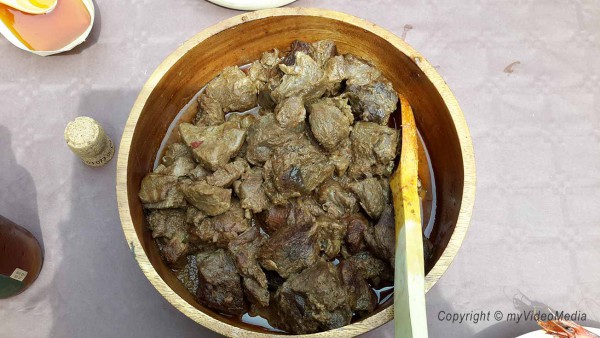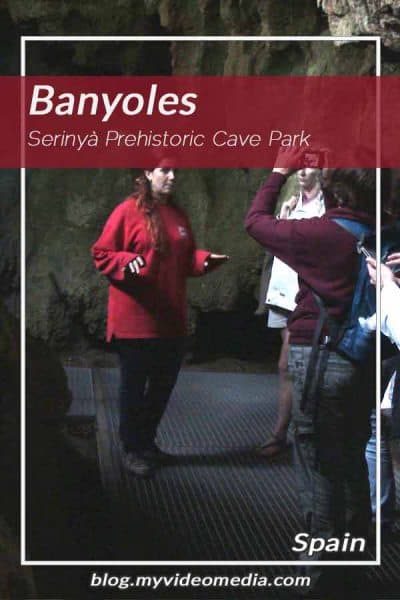The Serinyà Prehistoric Cave Park, just a few kilometers north of Banyoles, is an interpretation center devoted to Solutrean culture (18000-15000 BC), one of the most advanced civilizations of the first Homo sapiens in western Europe.
On the same site you find the prehistoric caves of Reclau. Therefore, the cave park also serves as educational center for all Paleolithic cultures that have lived in these caves from the Middle Paleolithic (250,000 to 200,000 BC) to the Magdalenian (15,000-9,000 BC).
Please watch the 4k UHD video here
You are currently viewing a placeholder content from YouTube. To access the actual content, click the button below. Please note that doing so will share data with third-party providers.
More InformationIn an exhibition hall, two large murals paintings show moments in life of the hunter-gatherers of that time. Reproductions of artifacts give an insight into their material culture. Before we start our exploration tour we see a video with an introduction to the prehistoric past, especially the history of Paleolithic caves.
Prehistoric Reclau caves
The archaeologist Neus Coromina guided us competently through the caves. The traces found in the caves – food scraps, fruits, seeds, bone – suggest that three different types of people have used these caves. Homo Erectus, the Neanderthals and the Homo Sapiens.

The caves were never a permanent domicile of the people, because at that time they were still hunters and collectors and with that nomads. They used the cave as a shelter during their migrations. Later, the caves were occasionally used as shelter, storage place for cereals and burial site.
Three important caves have been found.
Arbreda Cave
The Arbreda Cave is currently being excavated. It is the most important site, because it was inhabited by Neanderthals between 90,000 and 39,000 years and by the modern man from about 39,000-16,000.

The sand is sifted, because even the smallest splinter can indicate whether people have been working in the cave during prehistoric times. The cave doesn’t have it’s original structure, because a large part of the ceiling has collapsed.
Mollet Cave
The Mollet Cave has kept its original form quite well although a part of its outer top is lost. It is the cave with the oldest traces. Here, one found a tooth of a child dating back 200.000 years to the beginning of the Middle Palaeothic. It is the earliest example of human remains to be found in Catalonia.

Also remains of a fire place were found. This means that these people were already able to control the fire. But also the remains have been found by big game here. Hyena, bear, elephant, rhinoceros, lynx, horse, fallow deer, deer, bull, bison, donkey, rabbit and further can be proved here.
Reclau Viver cave
With respect to the original appearance, the Reclau Viver cave is the best preserved cave. It consists of two chambers, which are connected by a corridor. In the second room, the cave roof collapsed probably 15,000 years ago. Here one found a necklace of seashells.

Following the tour, we were allowed to try ourselves in archery (symbolic preparation for lunch) and cave paintings, with introduction from our guide Neus.

Afterwards she showed us the production of Neolithic tools. From a piece of bone she made a knife, using a piece of an antler. A mixture of resin and beeswax served as Paleolithic adhesive. Antler is particularly well suited for the production of tools, as well as tool for the work in the fields.

We were amazed, when Neus told us that she had been working in an internship for a whole summer to make a sewing needle. She had to grind the horn on a stone until it gets the desired shape. Due to the lengthy production time, needles were a precious commodity at that time.
Lighting a fire with flint, fibres of dried tree sponge and wood shavings turned out particularly difficult. Probably the tree sponge was not dry enough, but Neus didn’t give up and after 30 minutes a fire blazed up.

At the end a Stone Age lunch was served.

The meat and the scampi, prepared in a Stone Age way, where accompanied by nuts, berries and eggs.

To cut the meat, we could test the knife that our guide had produced before. The wine and cheese, however, were younger date. It tasted excellent.
It was an interesting journey into the past. In 2008 the park was declared a Cultural Asset of National Interest.
A visit to the Serinyà Prehistoric Cave Park is also highly recommended for families with children.
Please read on > Neolithic village of La Draga
Pin it for later

Disclosure : We thank the Tourist Board Costa Brava Girona as well as Consell Comarcal Pla de l’Estany for the organization and sponsoring. All views and opinions are our own and were not influenced!
Text, photos and video: Copyright © myVideoMedia